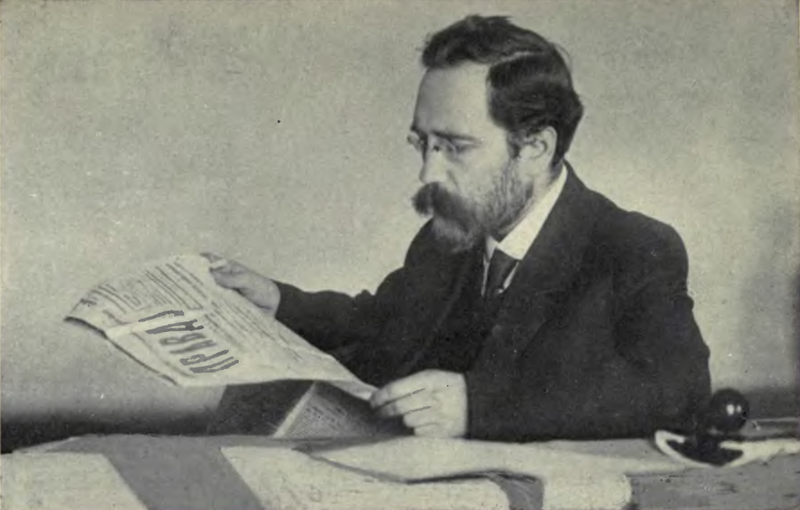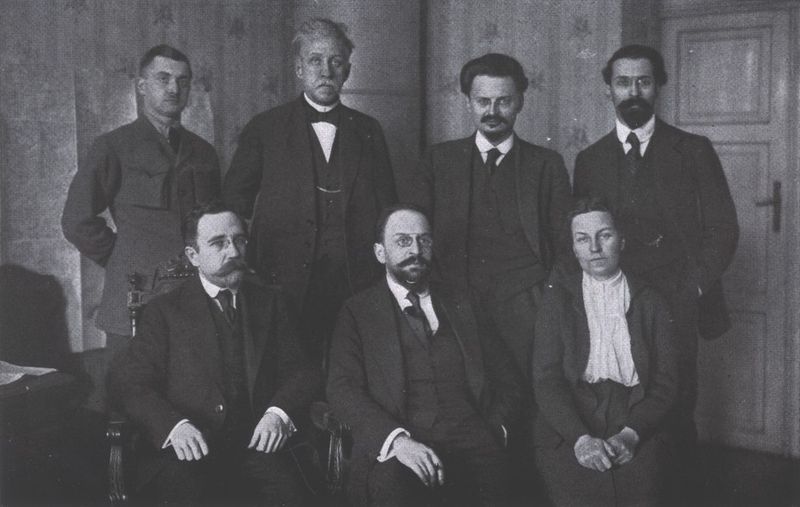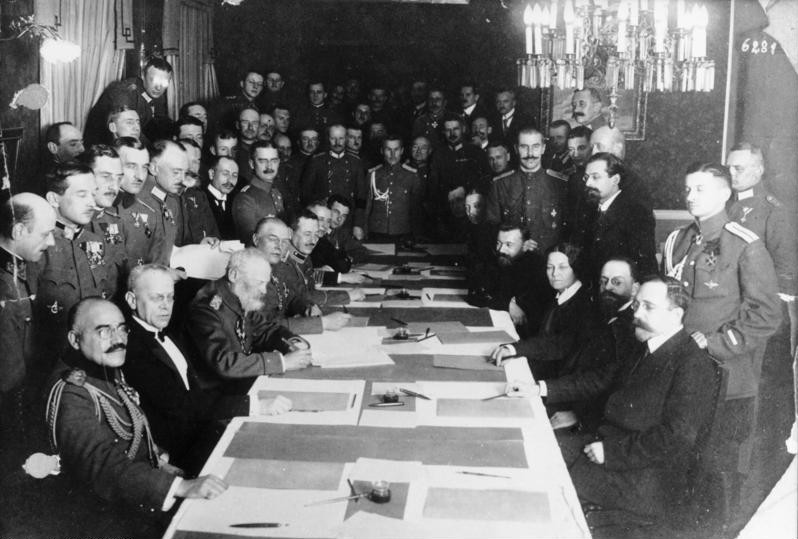<Back to Index>
- Deputy Chairman of the Council of People's Commissars of the Soviet Union Lev Borisovich Kamenev (Rozenfeld), 1883
PAGE SPONSOR
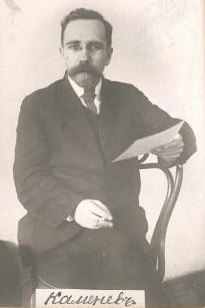

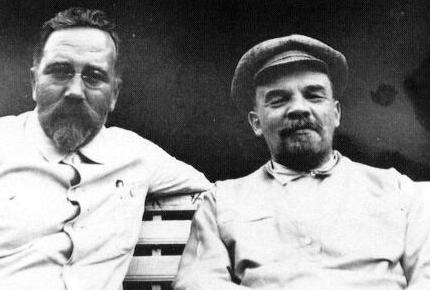
Lev Borisovich Kamenev (Russian: Лев Бори́сович Ка́менев; 18 July [O.S. 6 July] 1883 – 25 August 1936), born Rozenfeld (Russian: Ро́зенфельд), was a Bolshevik revolutionary and a prominent Soviet politician. He was briefly head of state of the new republic in 1917, and from 1923 - 24 the acting Premier in the last year of Lenin's life.
Kamenev was born in Moscow, the son of a Jewish railway worker and a Russian Orthodox mother. His father had grown rich building the Baku - Batumi railway. His father's wealth funded a good education for Lev. He went to the boy's Gymnasium in Tiflis, Georgia (now Tbilisi) and attended Moscow University, but his education was interrupted by an arrest in 1902. From that point on, he was a professional revolutionary, working in St. Petersburg, Moscow and Tiflis. Kamenev married a fellow Marxist (and Leon Trotsky's sister), Olga Kameneva, in the early 1900s and the couple had two sons. He joined the Communists in 1901 and supported Lenin. A brief trip abroad in 1902 introduced Kamenev to Russian social democratic leaders living in exile, including Vladimir Ilyich Ulyanov Lenin, whose adherent and close associate he became. He also visited Paris and met the Iskra group. After attending the 3rd Congress of the RSDLP Party in London in March 1905, Kamenev went back to Russia to participate in the Russian Revolution of 1905 in St. Petersburg in October – December. He went back to London to attend the 5th RSDLP Party Congress, where he was elected to the party's Central Committee and the Bolshevik Center, in May 1907, but was arrested upon his return to Russia. Kamenev was released from prison in 1908 and the Kamenevs went abroad later in the year to help Lenin edit Bolshevik magazine Proletariy. After Lenin's split with another senior Bolshevik leader, Alexander Bogdanov, in mid 1908, Kamenev and Grigory Zinoviev became Lenin's main assistants abroad. They helped him expel Bogdanov and his Otzovist (Recallist) followers from the Bolshevik faction of the RSDLP in mid 1909.
In January 1910 Leninists, followers of Bogdanov and various Menshevik factions held a meeting of the party's Central Committee in Paris and tried to re-unite the party. Kamenev and Zinoviev were dubious about the idea, but were willing to give it a try under pressure from "conciliator" Bolsheviks like Victor Nogin. Lenin was adamantly opposed to any re-unification, but was outvoted within the Bolshevik leadership. The meeting reached a tentative agreement and one of its provisions made Trotsky's Vienna based Pravda a party financed 'central organ'. Kamenev, Trotsky's brother - in - law, was added to the editorial board from the Bolsheviks, but the unification attempts failed in August 1910 when Kamenev resigned from the board amid mutual recriminations.
After the failure of the reunification attempt, Kamenev continued working in Proletariy and taught at the Bolshevik party school at Longjumeau near Paris that was created as a Leninist alternative to Bogdanov's Capri based party school. In January 1912, Kamenev helped Lenin and Zinoviev to convince the Prague Conference of Bolshevik delegates to split from the Mensheviks and Otzovists. In January 1914, he was sent to St. Petersburg to direct the work of the Bolshevik version of Pravda and the Bolshevik faction of the Duma. Kamenev was arrested after the outbreak of World War I and put on trial, where he distanced himself from Lenin's anti - war stance. Kamenev was exiled to Siberia in early 1915 and spent two years there until he was freed by the February Revolution of 1917.
Before leaving Siberia, Kamenev actually proposed sending a telegraph thanking the Tsar's brother Mikhail for refusing the throne. He was so embarrassed he denied ever sending it.
On March 25, 1917 Kamenev returned to St. Petersburg (the name was changed to Petrograd in 1914) from Siberian exile. Kamenev and Central Committee members Joseph Stalin and Matvei Muranov took control of the revived Bolshevik Pravda and moved it to the Right, with Kamenev formulating a policy of conditional support of the newly formed Russian Provisional Government and a reconciliation with the Mensheviks. After Lenin's return to Russia on 3 April 1917, Kamenev briefly resisted Lenin's anti - government April Theses, but soon fell in line and supported Lenin until September.
Kamenev and Zinoviev had a falling out with Lenin over their opposition to Soviet seizure of power in October 1917. On 10 October 1917 (Old Style), Kamenev and Zinoviev were the only two Central Committee members to vote against an armed revolt. Their publication of an open letter opposed to the use of force enraged Lenin, who demanded their expulsion from the party. However, when the Bolshevik led Military Revolutionary Committee headed by Adolph Joffe and the Petrograd Soviet, led by Trotsky, staged an uprising, Kamenev and Zinoviev went along. At the Second All - Russian Congress of Soviets Kamenev was elected Congress Chairman and Chairman of the permanent All - Russian Central Executive Committee. The latter position was equivalent to the head of state under the Soviet system.
On November 10, 1917, three days after the Soviet seizure of power during the October Revolution, the executive committee of the national railroad labor union, Vikzhel, threatened a national strike unless the Bolsheviks shared power with other socialist parties and dropped the uprising's leaders, Lenin and Trotsky, from the government. Zinoviev, Kamenev and their allies in the Bolshevik Central Committee argued that the Bolsheviks had no choice but to start negotiations since a railroad strike would cripple their government's ability to fight the forces that were still loyal to the overthrown Provisional Government. Although Zinoviev and Kamenev briefly had the support of a Central Committee majority and negotiations were started, a quick collapse of the anti - Bolshevik forces outside Petrograd allowed Lenin and Trotsky to convince the Central Committee to abandon the negotiating process. In response, Zinoviev, Kamenev, Alexei Rykov, Vladimir Milyutin and Victor Nogin resigned from the Central Committee on 4 November 1917 (Old Style) and Kamenev resigned from his Central Executive Committee post. The following day Lenin wrote a proclamation calling Zinoviev and Kamenev "deserters" and never forgot their behavior, eventually making an ambiguous reference to their "October episode" in his Testament.
In 1918, Kamenev became chairman of the Moscow Soviet and soon thereafter Lenin's Deputy Chairman of the Council of People's Commissars (government) and the Council of Labor and Defense.
In March, 1919, Kamenev was elected a full member of the first
Politburo. His personal relationship with his brother - in - law Trotsky,
which was good in the aftermath of the 1917 revolution and during the Russian Civil War, soured after 1920 and for the next 15 years he was a friend and close
ally of Grigory Zinoviev, a more ambitious man than Kamenev.
During Lenin's illness, Kamenev was the acting Council of People's Commissars and Politburo chairman. Together with Zinoviev and Joseph Stalin, he formed a ruling 'triumvirate' (or 'troika') in the Communist Party, and played a key role in the marginalization of Trotsky. The triumvirate carefully managed the intra - party debate and delegate selection process in the fall of 1923 during the runup to the XIIIth Party Conference and secured a vast majority of the seats. The Conference, held in January 1924 immediately prior to Lenin's death, denounced Trotsky and "Trotskyism".
After Trotsky's defeat at the XIIIth Conference, tensions between Zinoviev and Kamenev on the one hand and Stalin on the other hand became more pronounced and threatened to end their fragile alliance. Nevertheless, Zinoviev and especially Kamenev helped Stalin retain his position as General Secretary of the Central Committee at the XIIIth Party Congress in May – June 1924 during the first Lenin's Testament controversy. After the Congress, Stalin began making veiled public remarks apparently aimed at Kamenev and Zinoviev, which all but destroyed the troika.
However, in October 1924, Trotsky published The Lessons of October,
an extensive summary of the events of 1917. In the article, Trotsky
described Zinoviev and Kamenev's opposition to the Bolshevik seizure of
power in 1917, something that the two would have preferred left
unmentioned. This started a new round of intra - party struggle with
Zinoviev and Kamenev once again allied with Stalin against Trotsky. They
and their supporters accused Trotsky of various mistakes and worse
during the Russian Civil War and damaged his military reputation so much that he was forced to resign as People's Commissar of Army and Fleet Affairs and Chairman of the Revolutionary Military Council in
January 1925. Zinoviev demanded Trotsky's expulsion from the Communist
Party, but Stalin refused to go along and skillfully played the role of a
moderate.
With Trotsky on the sidelines, the Zinoviev - Kamenev - Stalin triumvirate finally began to crumble in early 1925. The two sides spent most of the year lining up support behind the scenes. Stalin struck an alliance with the Communist Party theoretician and Pravda editor Nikolai Bukharin and the Soviet prime minister Alexei Rykov. Zinoviev and Kamenev allied with Lenin's widow, Nadezhda Krupskaya and Grigori Sokolnikov, the People's Commissar for Finance and a candidate Politburo member. Their alliance became known as the New Opposition.
The struggle became open at the September 1925 meeting of the Central Committee and came to a head at the XIVth Party Congress in December 1925, when Kamenev publicly demanded removal of Stalin from the position of the General Secretary. With only the Leningrad delegation (controlled by Zinoviev) behind them, Zinoviev and Kamenev found themselves in a tiny minority and were soundly defeated while Trotsky remained silent during the Congress. Zinoviev was re-elected to the Politburo, but Kamenev was demoted from a full member to a non - voting member and Sokolnikov was dropped altogether, while Stalin had more of his allies elected to the Politburo.
Kamenev's first marriage began to disintegrate starting with Kamenev's reputed affair with the British sculptress Clare Frewen Sheridan in 1920. In the late 1920s he left Olga Kameneva for Tatiana Glebova, with whom he had a son, Vladimir Glebov (1929 – 1994).
During a lull in the intra - party fighting in the spring of 1926, Zinoviev, Kamenev and their supporters gravitated closer to Trotsky's supporters and the two groups soon formed an alliance, which also incorporated some smaller opposition groups within the Communist Party. The alliance became known as the United Opposition. During a new period of intra - Party fighting between the July 1926 meeting of the Central Committee and the XVth Party Conference in October 1926, the Opposition was defeated and Kamenev lost his Politburo seat at the Conference.
Kamenev
remained in opposition to Stalin throughout 1926 and 1927, resulting in
his expulsion from the Central Committee in October 1927. After the
expulsion of Zinoviev and Trotsky from the Communist Party on 12
November 1927, Kamenev remained the Opposition's chief spokesman within
the Party and represented its position at the XVth Party Congress in
December 1927. The Congress declared Opposition views incompatible with
membership in the Communist Party and expelled Kamenev and dozens of
leading oppositionists from the Party, which paved the way for mass
expulsions of rank and file oppositionists as well as internal exile of
opposition leaders in early 1928.
While Trotsky remained firm in his opposition to Stalin after his expulsion from the Party and subsequent exile, Zinoviev and Kamenev capitulated almost immediately and called on their supporters to follow suit. They wrote open letters acknowledging their mistakes and were readmitted to the Communist Party after a six month cooling off period. They never regained their Central Committee seats, but they were given mid level positions within the Soviet bureaucracy. Kamenev and, indirectly, Zinoviev, were courted by Bukharin, then at the beginning of his short and ill fated struggle with Stalin, in the summer of 1928, something that was soon reported to Joseph Stalin and used against Bukharin as proof of his factionalism.
Zinoviev and Kamenev remained politically inactive until October 1932, when they were expelled from the Communist Party for failure to inform on oppositionist party members during the Ryutin Affair. After once again admitting their supposed mistakes, they were readmitted in December 1933. They were forced to make self flagellating speeches at the XVIIth Party Congress in January 1934 when Stalin was parading his erstwhile political opponents, now defeated and outwardly contrite.
After the murder of Sergei Kirov on 1 December 1934 led to Stalin's Great Purges, Grigory Zinoviev, Kamenev and their closest associates were once again expelled from the Communist Party and arrested in December 1934. In this time he wrote a letter to Stalin. "At a time when my soul is filled with nothing but love for the party and its leadership, when, having lived through hesitations and doubts, I can boldly say that I learned to highly trust the Central Committee's every step and every decision you, Comrade Stalin, make," Kamenev wrote. "I have been arrested for my ties to people that are strange and disgusting to me.". They were tried in January 1935 and were forced to admit "moral complicity" in Kirov's assassination. Zinoviev was sentenced to ten years in prison and Kamenev to five. Kamenev was charged separately in early 1935 in connection with the Kremlin Case and, although he refused to confess, was sentenced to ten years in prison.
In August 1936, after months of careful preparations and rehearsals in Soviet secret police prisons, Zinoviev, Kamenev and 14 others, mostly Old Bolsheviks, were put on trial again. This time the charges including forming a terrorist organization that supposedly killed Kirov and tried to kill Joseph Stalin and other leaders of the Soviet government. This Trial of the Sixteen (or the trial of the "Trotskyite - Zinovievite Terrorist Center") was the first Moscow Show Trial and set the stage for subsequent show trials where Old Bolsheviks confessed to increasingly elaborate and monstrous crimes, including espionage, poisoning, sabotage, and so on. Like other defendants, Kamenev was found guilty and shot on 25 August 1936.
The execution of Zinoviev, Kamenev and their associates was notable because no Old Bolsheviks, much less prominent ones, had been put to death by Stalin's government until then.
Kamenev, Zinoviev and his co-defendants were formally cleared of all charges by the Soviet government in 1988 during perestroika.
After Kamenev's execution, his relatives suffered a similar fate. Kamenev's
second son, Yu. L. Kamenev, was executed on 30 January 1938, at the age
of 17. His eldest son, air force officer
A.L. Kamenev, was executed on 15 July 1939, at the age of 33. His first
wife, Olga, was shot on 11 September 1941 on Stalin's orders, in the
Medvedev forest outside Oryol, together with Christian Rakovsky, Maria Spiridonova and 160 other prominent political prisoners. Only his youngest son, Vladimir Glebov, survived Stalin's prisons and labor camps.
